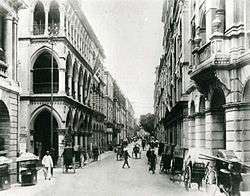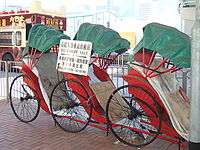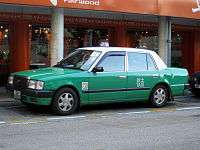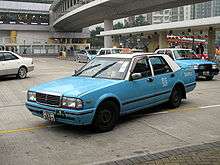Taxicabs of Hong Kong

Taxis of Hong Kong provide a taxi system. Although a few taxis are independently owned and operated, the vast majority are owned by 17 independent taxi companies that rent out taxis on a shift basis to 40,000 self-employed drivers.
As of 2003, there were 18,138 taxis in Hong Kong, of which 15,250 were urban taxis, 2,838 were New Territories taxis, and 50 were Lantau taxis. Every day they serve about 1.1 million, 207,900 and 1,400 people respectively.[1]
History
19th century

During the early colonial times, sedan chairs were the only form of public conveyance. Public chairs were licensed, and charged according to tariffs which would be prominently displayed.[2] Chair stands were found at all hotels, wharves, and major crossroads, and the sturdy chair bearers would clamour for regular patronage.
Much the same as motor cars nowadays, private chairs existed, and were an important marker of a person's status. A Civil officer's status was denoted by the number of bearers attached to his chair.[2]
Their numbers peaked in about 1920, when 1,215 registered sedan chairs were on the road.[3]

The rickshaw was first imported from Japan in 1870 by an American businessman. They were a popular form of transport for many years, peaking at more than 7,000 in the early part of the 20th century.[3] Rickshaws competed with sedan chairs for customers depending on their budget, haste, or terrain to be negotiated. The rickshaw was more rapid, but was not suited to climbing the steep terrain of Hong Kong Island.[3] Before Hong Kong's Peak Tram went into service in 1888, wealthy residents of The Peak were carried on sedan chairs by coolies up the steep paths to their residence, including former Governor Sir Richard MacDonnell's summer home, where they could take advantage of the cooler climate.[2]
However, the popularity of rickshaws waned after World War II. No new licenses for rickshaws have been issued since 1975, and licenses became non-transferable. Thus, a dying breed of only a few old men still ply their trade at the Edinburgh Place Ferry Pier, mainly for tourists. The rickshaw drawers charged HK$300 to go around the block.[4] There were about eight in 1998,[3] and only four left in 2002, and two in 2011.
The last sedan chair was reportedly abandoned in 1965,[3] and since the relocation of the Central Star Ferry pier at the end of 2006 the rickshaws have disappeared.
20th century
The Chinese name for taxi used in Hong Kong, dik si (的士), is a Cantonese transliteration of the English word "taxi". The earliest pioneer of the modern taxi service may have been Wu Zung (胡忠). In 1941, he is believed to have owned 40 taxis including 10 white cards, which he leased to the government. When the Japanese occupation of Hong Kong began in December of the same year, he suspended his transport operation. He resumed his business after the war with 100 cars.[5]
The service was first officially recorded by the government in 1947 with 329 cars.[6] By 1960 the service officially covered the New Territories, and the service increased to 1,026 cars. The number of taxis would multiply to 10,000 by 1980.
Prior to 1974, livery of taxis in Hong Kong depended on colours chosen by the licensees, although the Transport Department had noted considerable confusion for passengers caused by the proliferation of colours and mingling with private vehicles, and by December 1969 had started considering a uniform appearance for licensed taxis. On 13 September 1974, the government gazetted standard colours – silver for the upper half and red for the lower half – for all taxicabs in Hong Kong to weed out illegal taxis.[7] As most of the vehicles would cluster in Kowloon due to it being the population centre, and demand in the New Territories was being met by illegal operators, a licensed taxi service catering only for the New Territories was announced on 5 June 1976. From then onwards, "ordinary" (red) taxis would be allowed to continue to operate in the New Territories as well as Kowloon and Hong Kong Island, while the New Territories taxis – silver for the upper half and green for the lower half – would be forbidden from venturing into urban areas.[7] A batch of 20 blue taxis that serve Lantau Island started operating in 1983.
License




The taxi trade is regulated by the Government, as are the fare scales. Taxis need a license to operate in Hong Kong.
The service area of the three types of taxis are defined by the Government in the 1960s.[8] The need for the three different types was to avoid clustering of taxis in the more populated/profitable areas of the territory, and a shortage in others.[9] All three types of taxis serve Hong Kong International Airport and The Disneyland Resort.
The government stopped issuing licenses in 1994, when there were a total of 18,138 in the territory. Existing licenses are transferable, and are traded on the open market, and prices have been rising due to speculation, with fare rises tending to feed into the price of licences. The going cost for a license in 2011 is around HK$5 million – an increase of 36% from the year before. In 2013, market price peaked at $7 million.[10][11]
- Urban taxi
The red taxis have the highest fares among all, and serve all areas of New Territories, Kowloon and Hong Kong Island. They may also run Tung Chung (Lantau), the Airport at Chek Lap Kok (Lantau) and Disneyland, but are not permitted to run the rest of Lantau Island. These taxis can only carry passengers in the Lantau or New Territories areas if the passengers are returning to Kowloon or Hong Kong Island, or must return to their service areas themselves to continue their business. A taxi will sometimes appear with its roof light on, but with the 'For Hire' flag covered by an 'Out of Service' sign; this means they are attempting to catch a fare back across the harbour tunnel.
There is no legal requirement for drivers to know all the destinations in their allowed area. Commonly, drivers refuse to take passengers wanting to cross the harbour on this basis, although in theory drivers do not have the right to refuse a hire based on destination. On both sides of the harbour, the Government has erected taxi ranks catering for those returning taxis prepared to cross the harbour for a single-toll trip.
- New Territories taxi
The green taxis, the second most expensive, serve only parts of the New Territories, including Sha Tin, Tuen Mun, Yuen Long, Fanling, Sheung Shui, Pak Tam Chung, Tai Po, West of Ting Kau and North of Chuen Lung, except Lantau Island, Tsang Tai Uk, Sai Kung, Tsuen Wan, Kwai Chung and Tsing Yi. They are allowed to serve the taxi stands at Prince of Wales Hospital, Hin Keng Neighbourhood Community Centre, Chak on Estate, HKUST, Tseung Kwan O Hospital, Hang Hau Station, Tsing Yi Station and Tsuen Wan Station, which are designated interchange with red taxis. Although they serve the Airport and Disneyland, they do not serve Tung Chung and the rest of Lantau.
- Lantau taxi
The blue taxis run exclusively on southern Lantau Island, Tung Chung, the Airport and Disneyland, thus they are restricted to a small area. They are not quite as ubiquitous: there are only around 50 of them. There have been reports of some unofficial, unlicensed taxis in blue livery operating around these regions.
Fares
.jpg)
A fare table must be displayed clearly inside the taxi, by law. The same legally-enforceable fare table is also listed on the government's website.[8] Fares are charged according to distance travelled and waiting time, measured by a meter on board. There is a starting fare, and there are surcharges for luggage and tolled tunnels and bridges, as well as surcharges for telephone-arranged ordering. Along some restricted kerbs, there are designated pick-up and drop-off points exclusively for taxis. Some taxi operators will offer discounts to attract repeat business. Fares are determined by the government and revised from time to time upon the recommendation of the Transport Advisory Committee.[12] From December 2013, the flag fall – including the fare for the first two kilometres – was HK$22 for red taxis, HK$18.50 for green taxis and HK$17 for the blue Lantau cabs; thereafter, the meter adds $1.60 for every 200 metres.[12][11]
In July 2007, it was reported that many taxi drivers were engaged in rampant illegal price-cutting in their competition with call-cab drivers for passengers. Rates offered were up to 20% lower than the metered fares on long-distance trips, with competition being particularly fierce on the airport route. The warring factions took turns to blockade Hong Kong International Airport to air their grievances.[13] Andrew Cheng Kar-foo, chairman of the Legislative Council's transport panel, proposed cutting taxi fares to deal with illicit discounting. Representatives of call-cab drivers and taxi owners were opposed to the idea.[14] Urban taxi groups have been lobbying for permission to impose a HK$1 per trip fuel surcharge when the price of liquefied petroleum gas per litre is between HK$3.10 and HK$4. Legislative Councillors unanimously passed a motion urging the government to allow taxis to impose the surcharge. However, the vote was non-binding on the Government. The Transportation Secretary rejected the appeal.[15]
Cars used




Historically, Standard, DeSoto Deluxe, Morris Oxford, Hillman Minx, Austin 8, Austin Cambridge, Mercedes W120 Ponton, Ford Anglia, Vauxhall Cresta and Vauxhall Velox were used up to the 1960s. Since the 1970s, Japanese cars replaced the various European models used earlier. Among them, the Toyota Crown Comfort YXS10 and Nissan Cedric Y31 had always been the most popular.
All taxis bear a semi-circular green plate on the front grille, and at the back of the vehicle indicating the number of seats available. Throughout history, most Hong Kong taxis have been 4-door saloons with bench seats in the front, thus allowing it to carry up to five passengers (driver excluded). In the early 1980s, 4-passenger taxis were introduced. Smaller saloons such as the Nissan Bluebird 910, Nissan Sunny B12, Toyota Corona (CT141) and the Mitsubishi Lancer were used. However, these were all phased out by mid-1990s. Since then and until 2008, all Hong Kong taxis have been 5-passengers vehicles. But from 2008, the new Toyota Comfort equipped with new 2.0 VVT-i engine and equipped with floor shift automatic instead of column shift automatic, making the new Comfort a 4-passengers taxi again.
Australian Ford Falcon estate cars tried to enter the market in year 2000 but it was never popular.
Today, almost all taxis in Hong Kong are Toyota Comfort (YXS10) (over 99%), the minority being Nissan Cedric (Y31) saloons since Nissan Cedric (Y31) was discontinued from the end of 2005.
On 29 May 2007, there were reports that plans are afoot to introduce the LTI-licensed, Chinese Geely-manufactured, LPG-powered TX4 London Black Cabs into the Hong Kong taxi service market. A feasibility study is under way between the Hong Kong Productivity Council and Geely.[16][17]
On February 2013, Crown Motors introduced a new Toyota Prius(XW30) Hybrid Taxi to HK Taxi line up, but it is still not that common on the street.
On 11 December 2014 Honest Motors Unveil a new type of Taxi to HK, a Nissan NV200 Taxi. The taxi is powered by both gasoline and LPG.
On 5 February 2015 Ford also introduced a new Taxi – Ford Transit Connect Taxi, Power by a LPG 2.5L i-VCT engine.
All taxis are imported new, there is a type approval process for approving the models of cars to be used as taxis (which means unapproved models cannot be used as taxis). However, used parts of Japan are frequently used. So sometimes there are Japanese stickers on the taxis doors.
Most importers just import red colour base cars. For green and blue taxis, the owners have to convert the cars into the correct colour, and they usually only paint the exterior, and people can still see the original red colour from the door gap or engine compartment.
Fuels
Until the late 1990s, all Hong Kong taxis ran on diesel fuel, aside from 4-passenger taxis which ran on petrol. In 1996, a few taxis that ran on LPG appeared as part of the government's test project for alternative fuel. This project proved successful, leading to all new taxis being factory-built LPG since 1999. To speed up the replacement of diesel taxis with LPG ones, from mid 2000 to the end of 2003, the government offered a cash grant to each taxi owner who purchased a new LPG taxi during that period. Since 1 August 2001, no more diesel taxis were allowed to be imported into Hong Kong, and from 1 January 2006, driving a diesel taxi on the streets of Hong Kong became illegal. Therefore, all taxis in Hong Kong are currently running on LPG. Although LPG-powered vehicles are supposed to be relatively non-polluting, and do indeed reduce roadside pollution, a 2007 study by Polytechnic University indicated that older LPG taxis emitted at least double the amount of carbon monoxide and hydrocarbons compared to diesel. But the government still claimed that properly maintained LPG engines reduce pollution by 50% to 200%.
Different modes
Each taxi has a light on top of the vehicle which is illuminated when the taxi is available for hire. A "flag" visible on top of the dash board marked "for hire" also indicates a taxi is available. A taxi may have an 'Out of Service' sign on whenever the taxi is not available for hire, e.g., shift-changing. Passengers are not permitted to hire a taxi displaying an 'Out of Service' sign. Taxi drivers may continue to have a lit roof sign and 'For Hire' flag up if they are looking for customers wishing to head to areas in their service (e.g., an urban taxi in the New Territories, looking for fares heading to the urban area).
Representation
Taxi drivers' interests and those of owners are not necessarily aligned. Hong Kong Taxi Owners Association represents owners of taxi licences, and drivers, who are most frequently are not owners but who rent their vehicles on a daily basis, are represented by the Motor Transport Workers General Union.[7] In 2013, day-time drivers would pay upwards of HK$380 for each shift, and night shift drivers would pay HK$350. Owners would dispute with drivers' groups as they seek to increase the daily rental charge each time taxi fares increased.[11]
See also
| Wikimedia Commons has media related to Taxis in Hong Kong. |
References
- ↑ "Transport – Hong Kong: The Facts" (PDF). Government of Hong Kong. Retrieved 27 December 2013.
- 1 2 3 A Hong Kong Sedan Chair, Illustrations of China and Its People, John Thomson 1837–1921, (London,1873–1874)
- 1 2 3 4 5 Nury Vittachi, Riding out the rickshaw days, The Standard, 28 March 1998
- ↑ Kai Peter Yu, The way it was in those balmy days, The Standard, 30 January 1999
- ↑ "The construction of Hong Kong", Guangzhou government (广州市地方志馆). Retrieved 4 July 2007 (Chinese)
- ↑ HK Gov. "Taxi Annual Traffic report.", Transport Department, HK Government. Retrieved 23 February 2007
- 1 2 3 Sheets, Andrew (18 August 2016). "How Hong Kong taxis became red, green and blue". South China Morning Post.
- 1 2 "Operating index.." Transport Department, HK Government. Retrieved 23 February 2007.
- ↑ District Commissioner. [2006] Annual Departmental Report, New Territories. Nonprinted. No ISBN.
- ↑ "Investors queue up for HK$5m taxi ride", South China Morning Post, Anita Lam, 7 February 2011.
- 1 2 3 http://www.scmp.com/news/hong-kong/article/1317748/hong-kong-taxi-owners-promise-drivers-fare-share-price-hike
- 1 2 http://www.scmp.com/news/hong-kong/economy/article/1844308/hong-kongs-transport-advisory-committee-rejects-fuel
- ↑ Una So, "Light van man adds to airport taxi woe", The Standard, 16 July 2007
- ↑ Damon Pang, "Fare-cuts call for taxis hits skids", The Standard, 23 July 2007
- ↑ Nickkita Lau, "Taxi fuel surcharge drive shot down", The Standard, 31 October 2007
- ↑ "Hackney Carriages to be introduced into Hong Kong". Ming Pao (Chinese)
- ↑ "Probability of London Taxis in Hong Kong". RTHK (Chinese)
External links
- Information on Hong Kong taxis provided by Transport Department
- Taxi Hong Kong – Taxi Cab hotlines, rates and information
